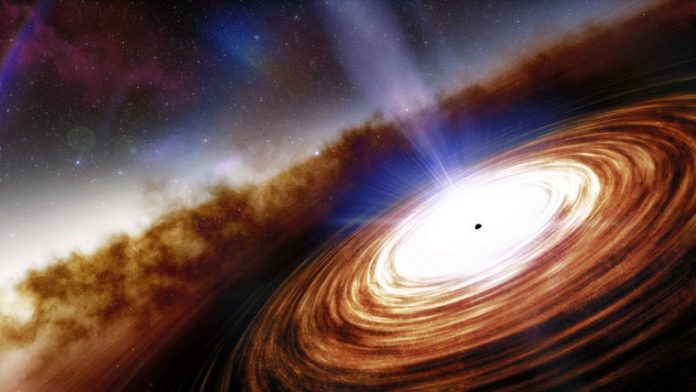The oldest, most distant “supermassive” black hole and quasar in the universe have both been discovered, researchers announced Tuesday.
At more than 13 billion years old, the black hole and quasar are the earliest yet seen, giving astronomers insight into the formation of massive galaxies in the early universe.
Quasars are thought to result from supermassive black holes gobbling up surrounding matter, such as gas or even entire stars, resulting in a maelstrom of superheated matter known as an accretion disk that swirls around the black hole.
Because of the enormous energies involved, quasars are among the brightest sources in the Universe, often outshining their host galaxies.
Although J0313-1806 is only 20 million light-years farther away than the previous record holder, ULAS J134208.10+092838.61, it contains a supermassive black hole twice as heavy. This marks a significant advancement for cosmology, as it provides the strongest constraint yet on the formation of black holes in the early Universe.
“This is the earliest evidence of how a supermassive black hole is affecting the galaxy around it,” said lead author Dr. Feige Wang, an astronomer with the Steward Observatory at the University of Arizona.
“From observations of less distant galaxies, we know that this has to happen, but we have never seen it happening so early in the Universe.”
“The most distant quasars are crucial for understanding how the earliest black holes formed and for understanding cosmic reionization — the last major phase transition of our Universe,” added co-author Professor Xiaohui Fan, also from the Steward Observatory at the University of Arizona.
Data from Pan-STARRS1 and the UKIRT Hemisphere Survey helped to first identify J0313-1806.
Once the astronomers confirmed its identity as a quasar, they obtained high-quality spectra from the W.M. Keck Observatory in Hawaii and the Gemini North telescope to measure the mass of the central supermassive black hole.
“Measurement of spectral lines that originate from gas surrounding the quasar’s accretion disk allows us to determine the black hole’s mass and study how its rapid growth influences its environment,” said co-author Professor Aaron Barth, an astronomer in the Department of Physics and Astronomy at the University of California, Irvine.
“For such distant quasars, the most important spectral lines are redshifted to near-infrared wavelengths and Keck’s NIRES spectrograph is an excellent instrument for these observations.”
The huge mass of J0313-1806’s black hole at such an early time in the Universe’s history rules out two theoretical models for how such objects formed.
In the first of these models, individual massive stars explode as supernovae and collapse into black holes that then coalesce into larger black holes.
In the second, dense clusters of stars collapse into a massive black hole.
In both cases, however, the process takes too long to produce a black hole as massive as the one in J0313-1806 by the age at which we see it.
“This tells you that no matter what you do, the seed of this black hole must have formed by a different mechanism,” Dr. Fan said.
“In this case, it’s a mechanism that involves vast quantities of primordial, cold hydrogen gas directly collapsing into a seed black hole.”
Follow-up observations of J0313-1806 with the Atacama Large Millimeter/submillimeter Array (ALMA) provided tantalizing details about the quasar host galaxy, which is forming new stars at a rate 200 times that of our Milky Way.
“This is a relatively high star formation rate in galaxies of similar age, and it indicates that the quasar host galaxy is growing very fast,” said co-author Dr. Jinyi Yang, also from the Steward Observatory at the University of Arizona.
J0313-1806’s brightness indicates that its supermassive black hole is swallowing the equivalent of 25 Suns every year.
The energy released by that rapid feeding probably is powering a powerful outflow of ionized gas seen moving at about 20% of the speed of light.
Such outflows are thought to be what ultimately stops star formation in the galaxy.
“We think those supermassive black holes were the reason why many of the big galaxies stopped forming stars at some point,” Dr. Fan said.
“We observe this quenching at later times, but until now, we didn’t know how early this process began in the history of the Universe.”
“J0313-1806 is the earliest evidence that quenching may have been happening at very early times.”
“This process also will leave the black hole with nothing left to eat and halt its growth.”















